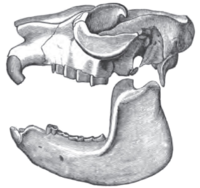- Mesotherium
-
Mesotherium
Temporal range: early to middle Pleistocene
skull of Mesotherium cristatum Scientific classification Kingdom: Animalia Phylum: Chordata Class: Mammalia Order: †Notoungulata Suborder: †Typotheria Family: †Mesotheriidae Genus: †Mesotherium
Serres, 1867Type species †Mesotherium cristatum Species - †M. cristatum
- †M. hystatum
- †M. maendrum
- †M. pachygnathum
Mesotherium ("Middle Beast"),[1] better known by its synonym, "Typotherium," is the type genus of Mesotheriidae, a long-lasting (roughly from 55 to 2 mya) family of superficially rodent-like, burrowing notoungulates from South America. It was first named by Étienne Serres in 1867, and through further finds now contains four species, M. cristatum, M. hystatum, M. maendrum, and M. pachygnathum.
Contents
Etymology
Serres named Mesotherium so due to his belief that it was an intermediate between rodents and pachyderms (or ungulates), due to its large upper incisors, and its size and proportions.[1] "Serres—by a happy inspiration proposed calling it Mesotherium—as being a common centre towards which all mammalia got happily confounded," Hugh Falconer wrote Darwin in April 1863.[2] "Bravard sent it home under the name of Typotherium as being the central type from which all mammals diverged." It was Serres' view that there was only one underlying animal type.
Despite Serres' having officially named the genus Mesotherium, it was known from the late 19th century to the early 20th century under the name "Typotherium", given it by the French palaeontologist living in Argentina, Auguste Bravard;[3] under this name Bravard sent the skull he found to Paris, which led to the family being named Typotheriidae, and served as the basis for the order Typotheria.[1] As the name "Mesotherium" had been published earlier in the same year as "Typotherium", Mesotherium was declared the valid name of the genus, (Simpson, 1980[3]) and Mesotheriidae the valid name of the family.[1] Nevertheless, as the rules do not apply to anything above the family, the name of the order Typotheria is still in use, but refers to a wider range of rodent-like notoungulates.[1]
Description
Mesotherium was likely the size of a small sheep, and weighed around 55 kilograms (120 lb).[1] Like most rodents, it had superficially long upper incisors, which met at the tips,[1] however, it had enamel on both the labial and lingual surfaces of the incisors, while rodents only have enamel on the labial surface.[1] Mesotherium's lower incisors were reminiscent of those of a rabbit's.[1]
Mesotherium's ankle joint was made up of a "ball-and-socket" arrangement between the astralagus and the navicular, as well as a sliding articulation of the calcaneocuboid joint, which would cause extension-flexion in the ankle, as well as supination-pronation of the foot.[4] Because of this, Florentino Ameghino predicted in 1905, and confirmed in 1906 that Mesotherium would have a great toe.[4]
Mesotherium was likely fossorial, in that it dug, possibly to find food.[1][4]
References
- ^ a b c d e f g h i j D. Croft SA Mammals: Mesotheriidae "D. Croft SA Mammals: Mesotheriidae". D. Croft. 2007-01-02. http://www.dcpaleo.org/Research/SAMammals/Notoungulata/Mesotheriidae/Mesotheriidae.html D. Croft SA Mammals: Mesotheriidae. Retrieved 2008-06-05.
- ^ Darwin Correspondence Project: Letter dated 20 April [1863],
- ^ a b The Correspondence of Charles Darwin: Volume 11,; page 333. 1863 (The Correspondence of Charles Darwin) by Charles Darwin, Frederick Burkhardt, Duncan Porter, and Sheila Ann Dean) ISBN 0521590337 Retrieved on 2008-05-02
- ^ a b c "Analysis of function in the absence of extant functional homologues: a case study using mesotheriid notoungulates (Mammalia)". Bruce Shockey, Darin Croft, and Frederico Anaya. Spring, 2007. http://findarticles.com/p/articles/mi_qa4067/is_200704/ai_n19432526/pg_11. Retrieved 2008-07-10.
Further reading
- The Origin and Evolution of Mammals (Oxford Biology) by T. S. Kemp
- Horns, Tusks, and Flippers: The Evolution of Hoofed Mammals By Donald R. Prothero, Robert M. Schoch Published 2003 JHU Press ISBN 0801871352
- Forms of Animal Life: A Manual of Comparative Anatomy By George Rolleston, William Hatchett Jackson Published 1888 Clarendon Press
- The Century Dictionary: An Encyclopedic Lexicon of the English Language By William Dwight Whitney. Published 1890 The Century Company; original from Harvard University.
- Classification of Mammals Above the Species Level: Above the Species Level By Malcolm C. McKenna, Susan K. Bell, George Gaylord Simpson. Published 1997 Columbia University Press. ISBN 0231110138
- Neanderthals Revisited: New Approaches and Perspectives By Katerina Harvati, Terry Harrison. Publisher Springer ISBN 1402058446
External links
Categories:- Notoungulates
- Pleistocene mammals
- Pleistocene extinctions
Wikimedia Foundation. 2010.
